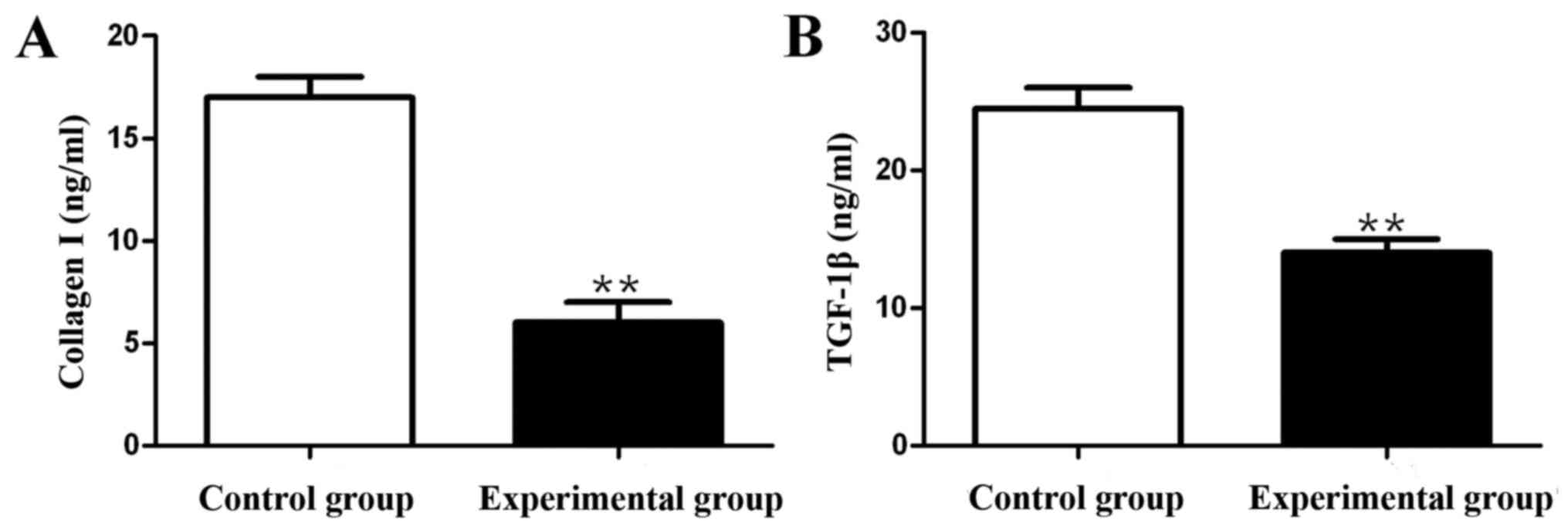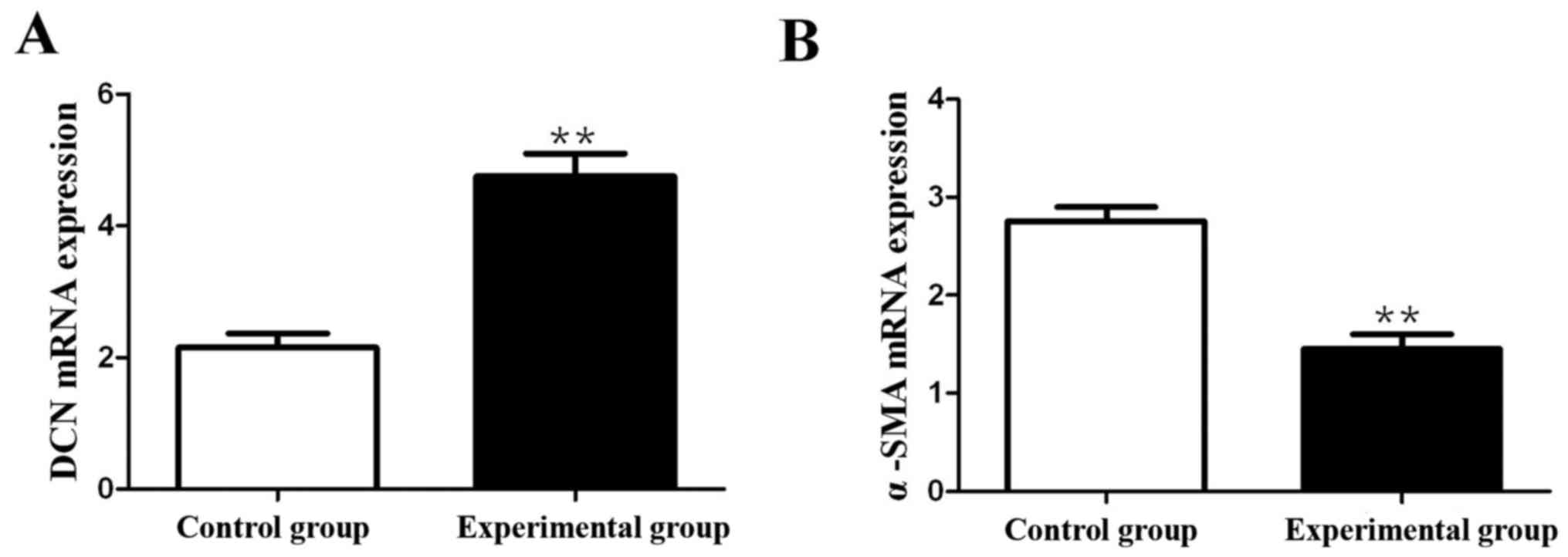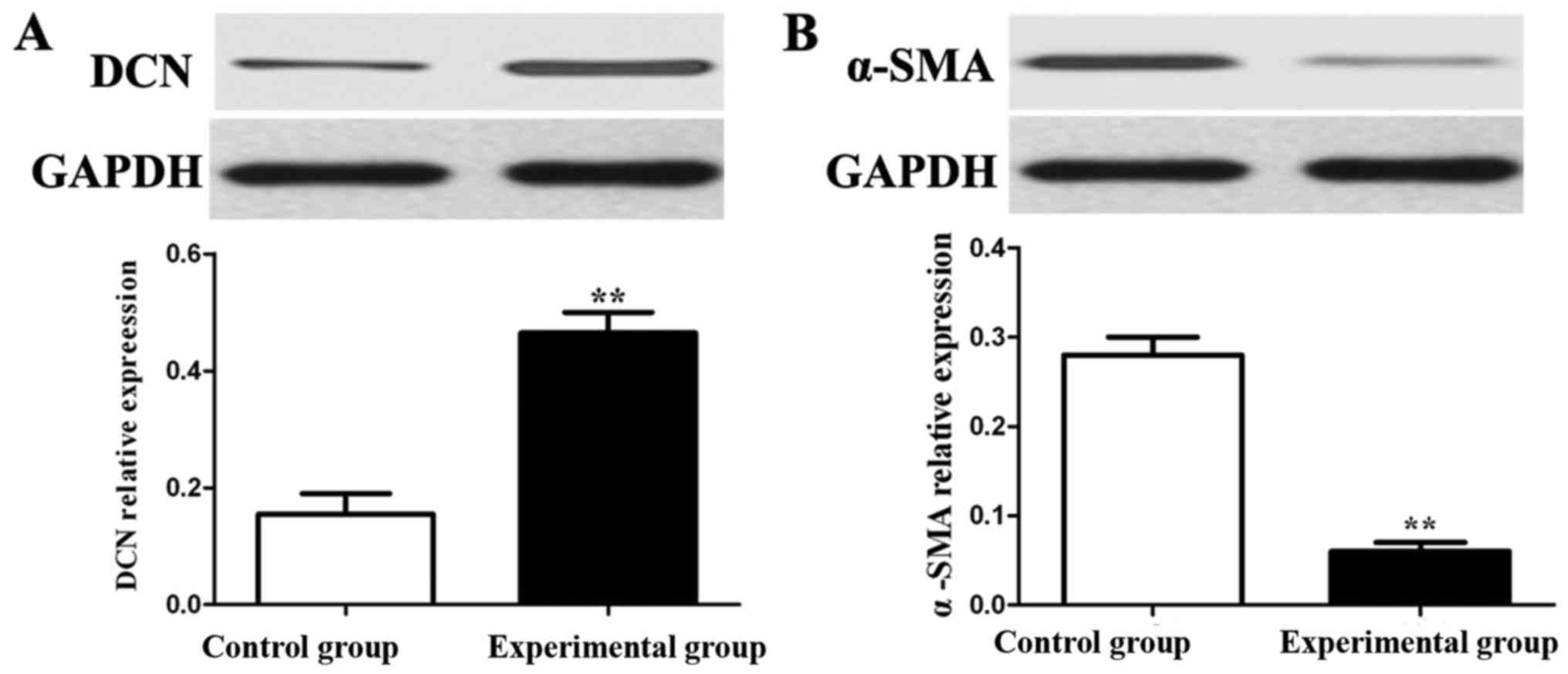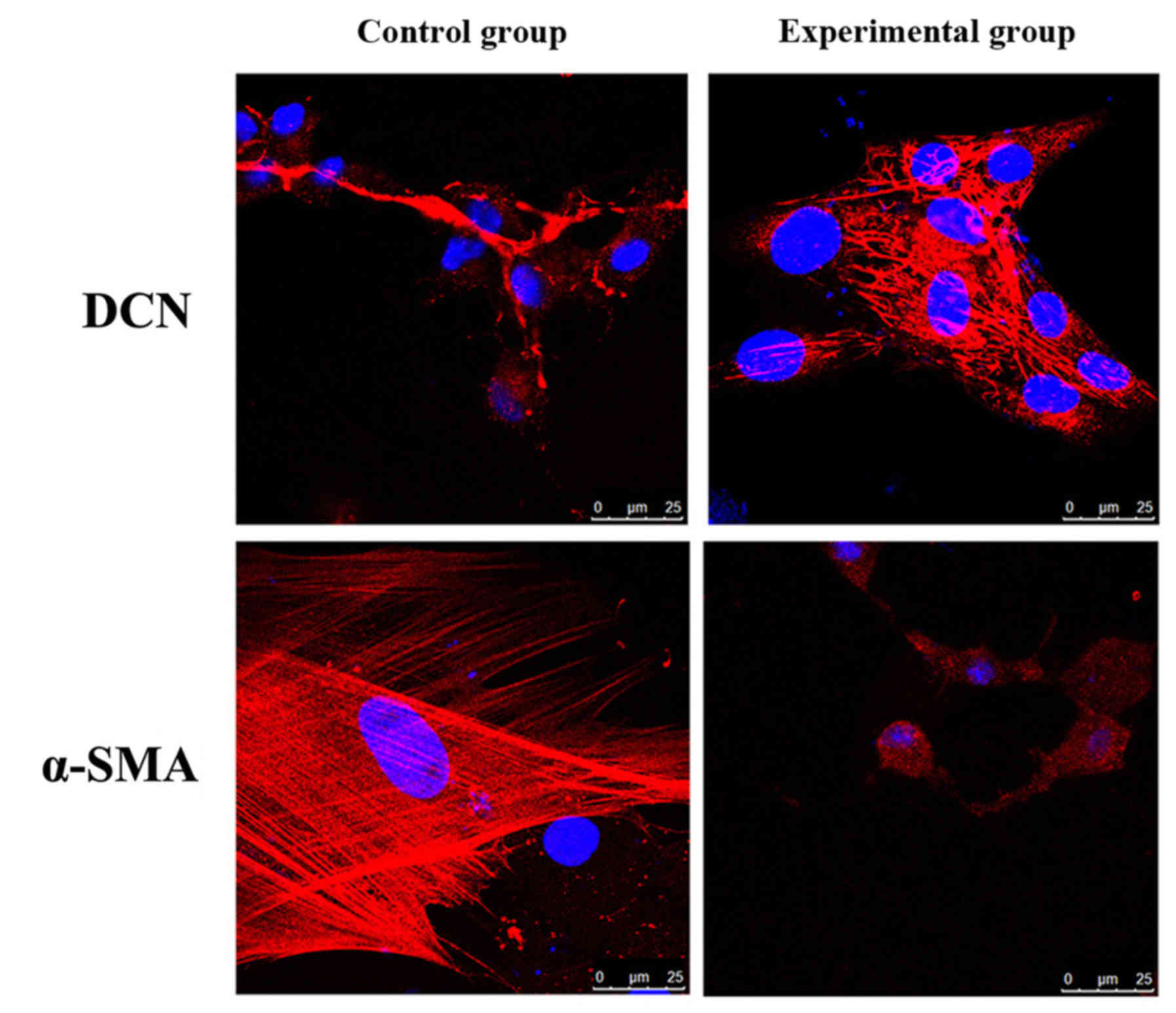Introduction
Scar is a general term of changes in histopathology
and appearance of skin tissues caused by various wounds, and the
clinical incidence rate of scar can be as high as 40–70%,
especially in the skin burn, postoperative period and trauma
(1). Scar generation not only brings
the physical and mental pain for patients, but also causes the
appearance damage or even dysfunction to relevant tissues. The
clinical scar repair in plastic surgery is also an important
problem faced by the doctors. At present, the clinical treatment
measures and means are not the same due to different types, size
and special parts of scars. The most commonly used methods include
suture after surgical resection, skin grinding, soft tissue
expansion and flap transplantation, and the non-surgical treatment
means include laser, drug injection, freezing and compression;
however, none of the above methods can thoroughly cure the scar. In
addition, these treatment methods also have their own limitations
and different degrees of adverse reactions (2). A large number of studies have shown
that there is a kind of stem cell in adipose tissues, namely the
adipose derived stem cells (ADSCs) that still retain the
differentiation potential (2,3). ADSCs
have the functions of synthesis and secretion of a variety of cell
growth factors (4,5), and these cytokines can act on
fibroblasts and affect the synthesis and metabolism of collagen and
other extracellular matrixes (6,7), so it
is inferred that ADSCs can inhibit the fibrosis of scar fibroblasts
in in vitro culture system.
To investigate the effects of transplanted ADSCs on
the expressions of α-smooth muscle actin (α-SMA) and decorin (DCN)
in fibroblasts of hypertrophic scar tissues in rabbit ears, ADSCs
and hypertrophic scar fibroblasts were co-cultured in vitro
in this study, so as to provide theoretical support for the new
clinical treatment mechanism of hypertrophic scar tissues.
Materials and methods
Materials
Dulbecco's modified Eagle's medium (DMEM), fetal
bovine serum (FBS), trypsin and ethylenediaminetetraacetic acid
(EDTA) (Invitrogen; Thermo Fisher Scientific, Inc., Waltham, MA,
USA); α-SMA and DCN primer sequences (Beijing Sunbiotech Co. Ltd.,
Beijing, China); immunofluorescence kit (Corning Incorporated,
Corning, NY, USA); primary antibodies: Rabbit monoclonal anti-α-SMA
and rabbit polyclonal to Decorin (1:1,000; cat. nos. ab150301 and
ab137508 respectively, both obtained from Abcam, (Cambridge, MA,
USA); secondary antibody, goat anti-mouse IgG-HRP (1:2,000; cat.
no. ab6789; Abcam); enzyme-linked immunosorbent assay (ELISA) kit,
bicinchoninic acid (BCA) protein quantification kit and cell lysis
buffer (Beyotime Institute of Biotechnology, Haimen, China).
Establishment of rabbit ear scar
model
Twelve male adult New Zealand white rabbits weighing
between 2.5 and 3.5 kgs were purchased from Laboratory Animal
Center of Jining First People's Hospital (Jining, China). The
animals were single-housed under standard conditions at 22±2°C with
a 12 h light/dark cycle and fed ad libitum. Rabbits were
accommodated to the holding room for at least 1 week before the
initiation of experiments. All rabbit experiments were designed to
minimize suffering and reduce the number of animals used. Rabbits
were anesthetized with intramuscular injection of ketamine (45
mg/kg) and xylazine (5 mg/kg). Rabbit ears were pressed slightly,
and the red mark could be seen but the skin was not damaged. The
skin was cut along the red mark using the scalpel without damaging
the ear cartilage; the whole round skin was removed and the
subcutaneous tissue and cartilage membrane were peeled off in
operation, and the integrity of cartilage surface was maintained.
The wound was pressed using gauze for 5 min to prevent excessive
bleeding. After the operation without bleeding in wound any longer,
the erythromycin eye ointment was wiped on each wound. After
operation, penicillin and chloramphenicol were used in a timely
manner; if there was wound infection or even necrosis, it should be
promptly removed. Animal treatments were carried out in line with
the international ethical clauses concerning the Care and Use of
Laboratory Animals of Jining First People's Hospital, and performed
in accordance with the Guidelines for Laboratory Animals of the
National Research Council of USA (1996).
Extraction and culture of ADSCs
After the big-ear rabbits were weighed and
anesthetized, the fat in left inguinal fold was removed using eye
scissors, peeled off and washed with phosphate buffered saline
(PBS) containing antibiotics. Then the fat was placed in the
sterile centrifuge tube and cut into pieces. Type I collagenase (10
ml) (1 mg/ml) was added for digestion in the shaker at 37°C,
followed by centrifugation at 1,000 × g for 10 min in the
centrifugal machine; then the supernatant was removed, and the
culture solution was added into the original centrifuge tube. After
the mixture was shaken evenly, it was filtered through the 200-mesh
gauze and cultured in an incubator with 5% CO2 at 37°C.
The culture solution (DMEM culture solution containing 10% FBS) was
replaced every other day, followed by passage at a ratio of
1:3.
Scar fibroblast separation and
culture
Scar tissues were peeled off with eye scissors and
washed thoroughly with PBS containing antibiotics; then they were
cut into pieces with surgical scissors and transferred into the
centrifugal tube; then dispase (4 mg/ml) was added for
decomposition on the shaker at 37°C for 45 min; other methods and
steps were the same as those in 1.3.
Co-culture of ADSCs and scar
fibroblasts
The third-generation ADSCs cultured were treated
into the cell density of 5×104/ml, while the
third-generation hypertrophic scar fibroblasts were treated into
the cell density of 2×104/ml. Co-culture group:
Transwell co-culture plates with the inner membrane pore size of
0.4 pm were selected and ADSCs and scar fibroblasts were
co-cultured. ADSCs (1 ml) with a density of 5×104/ml
were added into the upper layer, while 1 ml scar fibroblasts with a
density of 2×104/ml were added into the lower layer
using the non-contact co-culture mode. Control group: Scar
fibroblasts (1 ml) with a density of 2×104/ml were
cultured in an ordinary 6-well plate, and the medium was added
until the volume was 2 ml. After the co-culture for 21 days, the
cells were collected for subsequent experiments.
Detection of contents of collagen I
and transforming growth factor-β1 (TGF-β1) using ELISA kit
The fibroblasts in experimental and control group
were collected. After decomposition, they were centrifuged at 1,000
× g for 10 min; then the supernatant was taken into the Eppendorf
(EP) tube to detect the contents of collagen I and TGF-β1 in
fibroblasts using the ELISA kit.
Detection of mRNA expressions of α-SMA
and DCN via reverse transcription-polymerase chain reaction
(RT-PCR)
The fibroblasts in experimental and control group
were collected. The total RNA was extracted from cells according to
the instructions of RNA extraction kit, and the qualified total RNA
was selected for reverse transcription in accordance with the
instructions of reverse transcription kit. The specific reaction
conditions were as follows: Incubation at 42°C for 15 min,
incubation at 95°C for 3 min; after that, the total RNA was cooled
on ice and then stored in a refrigerator at −80°C for subsequent
experiment. The routine amplification was performed according to
the primer sequences in Table I.
With β-catenin as the internal control gene, Cq values were output
from the instrument; the relative expression levels of α-SMA and
DCN mRNA were calculated using the 2−∆∆Cqmethod
(8).
 | Table I.RT-PCR primer sequences. |
Table I.
RT-PCR primer sequences.
| Genes | Primer name | Primer sequence |
|---|
| α-SMA | F |
5′-CCTGAAGAGCATCCCACCCT-3′ |
|
| R |
5′-CATCCCAGAGTCCAGCACGA-3′ |
| DCN | F |
5′-AATAACCGAAATCAAAGATGGAGAC-3′ |
|
| R |
5′-CGGATTGGTGCCCAGTTCTA-3′ |
| β-actin | F |
5′-TGGCACCCAGCACAATGAA-3′ |
|
| R |
5′-CTAAGTCATAGTCCGCCTAGAAGCA-3′ |
Detection of α-SMA and DCN protein
expressions via western blot analysis
The fibroblasts in experimental and control groups
were collected, and the cells were resuspended using the cell lysis
buffer, and cleaved on ice for 30 min, followed by centrifugation
at 12,000 × g at 4°C for 15 min. The supernatant was carefully
absorbed as the total protein. After protein quantification using
the BAC protein quantification kit, the loading buffer was added,
60 µg proteins in each group were taken for 10% sodium dodecyl
sulfate polyacrylamide gel electrophoresis (SDS-PAGE), and the
proteins were transferred onto the polyvinylidene fluoride (PVDF)
membrane. The membrane was sealed using Tris-buffered saline (TBS)
containing 5% skimmed milk at room temperature for 1 h, primary
antibodies with cat. nos. ab150301 and ab137508 both from Abcam,
were added dropwise for incubation at 4°C overnight. On the next
day, the membrane was washed with Tris-buffered saline Tween (TBST)
for three times (15 min/time). Then secondary antibody, goat
anti-mouse IgG-HRP (1:2,000; cat. no. ab6789; Abcam) was added for
incubation at room temperature for 1 h, followed by washing with
TBST, luminous reaction using electrochemiluminescence (ECL) kit,
image scanning and analysis, and gray scale analysis with
glyceraldehyde-3-phosphate dehydrogenase (GADPH) as the internal
reference.
Detection of α-SMA and DCN protein
expressions in fibroblasts via immunofluorescence assay
After the cells grew on the glass slide, they were
fixed with pre-cooled paraformaldehyde, washed with PBS, permeated
with 0.2% Triton X-100 for 10 min, and washed again with PBS for
three times; then cells were sealed with the serum of the same host
for 30 min, and washed with PBS for three times. The primary
antibodies with cat. nos. ab150301 and ab137508 (Abcam) were added
in the wet box overnight, and then cells were washed with PBS for
three times, the secondary antibody with cat. no. ab6789 (Abcam)
was added at room temperature for 2 h in a dark place, and washed
again with PBS for three times. After nuclear staining with DAPI,
they were photographed under fluorescence microscope (SZ61; Olympus
Corporation, Tokyo, Japan).
Statistical analysis
SPSS 17.0 software (SPSS, Inc., Chicago, IL, USA)
was used for data processing in this study. Measurement data were
presented as mean ± standard deviation, and t-test was used for
intergroup comparisons. Chi-square test was used for intergroup
comparisons of enumeration data. P≤0.05 suggested that the
difference was statistically significant.
Results
Effects of ADSCs on collagen I and
TGF-β1 contents in fibroblasts
Compared with those in control group, the content of
collagen I was decreased by 65.7% and the content of TGF-β1 was
decreased by 39.8% in experimental group, and the differences were
statistically significant (p<0.01) (Fig. 1).
Effects of ADSCs on mRNA expressions
of DCN and α-SMA in fibroblasts
RT-PCR was performed to detect the effects of ADSCs
on mRNA expressions of DCN and α-SMA in fibroblasts. The results
showed that compared with those in control group, the mRNA
expression of DCN in fibroblasts in experimental group was
significantly increased (p<0.01), but the mRNA expression of
α-SMA was significantly decreased (p<0.01) (Fig. 2).
Detection of effects of ADSCs on
protein expressions of α-SMA and DCN in fibroblasts via western
blot analysis
Western blot analysis was performed to detect the
effects of ADSCs on protein expressions of α-SMA and DCN in
fibroblasts. The results showed that compared with those in control
group, the protein expression of DCN in fibroblasts in experimental
group was obviously increased (p<0.01), but the protein
expression of α-SMA was obviously decreased (p<0.01) (Fig. 3).
Detection of effects of ADSCs on
protein expressions and distribution of α-SMA and DCN in
fibroblasts via immunofluorescence assay
The effects of ADSCs on protein expressions and
distribution of α-SMA and DCN in fibroblasts were detected via
immunofluorescence assay. The results showed that compared with
those in control group, the protein expression of DCN in
fibroblasts in experimental group was significantly increased, but
the protein expression of α-SMA was significantly decreased
(Fig. 4).
Discussion
When the skin tissue undergoes trauma repair, scar
formation is unavoidable. The mechanism of scar formation is not
yet fully elucidated at present, but its histological features are
characterized by hyperplasia of fibroblasts and higher synthesis
rate of extracellular matrix than degradation rate (9). At present, the clinical treatment means
of hypertrophic scar are not uniform, and the effects are
unsatisfactory (10). So the further
study on its treatment mechanism and new treatment program has
become one of the hot spots.
Hypertrophic scars are caused by excessive healing
of dermal fibrosis cell. Dermal fibroblasts are in hyperplasia
during post-traumatic repair, the synthesis rate of extracellular
matrix is significantly greater than the degradation rate, and the
inflammation exists in the wound, so the combined action of these
factors leads to the pathological scars (11,12).
α-SMA is the cytoskeletal protein that binds to fibrin and exerts
contraction. At normal levels, α-SMA is widely distributed in
muscle and vascular smooth muscles, but the expression of α-SMA is
increased in the abnormal conditions and it promotes the maturation
of myofibroblasts. Besides, α-SMA can not only promote wound
healing, but also synthesize and secrete a large number of
collagens, growth factors and enzymes. When the balance between
secretion and degradation of extracellular matrix is broken,
pathological scar can appear (13).
In addition, fibroblasts can also synthesize DCN. As one of the
most important proteoglycans in normal dermis, DCN is a kind of
extracellular small-molecular complex rich in leucine, composed of
core protein and polysaccharose. Core protein is the most critical
in DCN, which can transmit different biological signals and resist
the scar generation. Studies have shown that DCN can significantly
inhibit the proliferation of fibroblasts (14). Similarly, some studies have revealed
that DCN binds to TGF-β1 to significantly reduce its activity,
thereby inhibiting the activity of fibroblasts and reducing the
occurrence of fibrosis. When the content of DCN is reduced in the
dermal cell layer is reduced, the scar hyperplasia will be obvious
(15). DCN can inhibit the
fibroblast activity in skin tissues, and the increased DCN content
in human lung fibroblasts can also reduce the activity of α-SMA and
exert the anti-fibrosis effect (16). Under physiological conditions,
collagen fibers are arranged normally in a reticular structure, and
the collagen metabolism and deposition are in a balanced state; but
in hypertrophic scars, the expression of collagen I is
significantly increased, other components in extracellular matrix
are fewer, and the collagen deposition is excessive with different
arrangement state (17,18).
In this experiment, after the rabbit ear
hypertrophic scar model was established successfully, the
fibroblasts of hypertrophic scar tissues in rabbit ears were
separated and cultured using the mechanical method combined with
enzyme digestion, and the ADSCs and scar fibroblasts were cultured
in non-contact Transwell co-culture system for 21 days
(experimental group); the corresponding scar fibroblasts were
cultured in an ordinary 6-well plate without any treatment for 21
days (control group). The results of ELISA showed that the content
of collagen I in experimental group was significantly decreased
compared with that in control group, which were consistent with the
research results in the scar formation after burn (19,20),
suggesting that skin wound regeneration is closely related to the
increased content of collagen I, and reducing the collagen I
expression may play an important role in the prevention and
treatment of scar. The results of RT-PCR and western blot analysis
revealed that the mRNA and protein expressions of α-SMA in
experimental group were significantly decreased, while those of DCN
were significantly increased. Immunofluorescence assay showed that
the expression of α-SMA was obviously decreased, while the
expression of DCN was significantly increased in experimental
group. Studies have shown that the main mechanism of hypertrophic
scar is not the decline in degradation, but the synthesis
capability of scar collagen far outweighing the degradation
capability, accompanied by the decreased DCN synthesis and
significantly increased expression of α-SMA (21).
In conclusion, ADSCs can inhibit the mRNA and
protein expressions of α-SMA and promote the mRNA and protein
expressions of DCN in in vitro culture system, suggesting
that they are expected to be used in the prevention and treatment
of pathological scars.
Acknowledgements
Not applicable.
Funding
No funding was received.
Availability of data and materials
The datasets used and/or analyzed during the present
study are available from the corresponding author on reasonable
request.
Authors' contributions
HC and YW contributed to the conception of the
study. XW contributed significantly to data analysis and manuscript
preparation. XS performed the data analyses and wrote the
manuscript. HL and XL helped perform the analysis with constructive
discussions. All authors read and approved the final
manuscript.
Ethics approval and consent to
participate
The study was approved by the Εthics Committee of
Jining First People's Hospital (Jining, China).
Patient consent for publication
Not applicable.
Competing interests
Authors declare they have no competing
interests.
References
|
1
|
Kim S, Choi TH, Liu W, Ogawa R, Suh JS and
Mustoe TA: Update on scar management: Guidelines for treating Asian
patients. Plast Reconstr Surg. 132:1580–1589. 2013. View Article : Google Scholar : PubMed/NCBI
|
|
2
|
Zuk PA, Zhu M, Ashjian P, De Ugarte DA,
Huang JI, Mizuno H, Alfonso ZC, Fraser JK, Benhaim P and Hedrick
MH: Human adipose tissue is a source of multipotent stem cells. Mol
Biol Cell. 13:4279–4295. 2002. View Article : Google Scholar : PubMed/NCBI
|
|
3
|
Wang G, Ren Y, Cao W, Yang Y and Li S:
Liposculpture and fat grafting for aesthetic correction of the
gluteal concave deformity associated with multiple intragluteal
injection of penicillin in childhood. Aesthetic Plast Surg.
37:39–45. 2013. View Article : Google Scholar : PubMed/NCBI
|
|
4
|
Guisantes E, Fontdevila J and Rodríguez G:
Autologous fat grafting for correction of unaesthetic scars. Ann
Plast Surg. 69:550–554. 2012. View Article : Google Scholar : PubMed/NCBI
|
|
5
|
Klinger M, Marazzi M, Vigo D and Torre M:
Fat injection for cases of severe burn outcomes: A new perspective
of scar remodeling and reduction. Aesthetic Plast Surg. 32:465–469.
2008. View Article : Google Scholar : PubMed/NCBI
|
|
6
|
Kim WS, Park BS, Sung JH, Yang JM, Park
SB, Kwak SJ and Park JS: Wound healing effect of adipose-derived
stem cells: A critical role of secretory factors on human dermal
fibroblasts. J Dermatol Sci. 48:15–24. 2007. View Article : Google Scholar : PubMed/NCBI
|
|
7
|
Bruno A, Delli Santi G, Fasciani L,
Cempanari M, Palombo M and Palombo P: Burn scar lipofilling:
Immunohistochemical and clinical outcomes. J Craniofac Surg.
24:1806–1814. 2013. View Article : Google Scholar : PubMed/NCBI
|
|
8
|
Livak KJ and Schmittgen TD: Analysis of
relative gene expression data using real-time quantitative PCR and
the 2(-Delta Delta C(T)) method. Methods. 25:402–408. 2001.
View Article : Google Scholar : PubMed/NCBI
|
|
9
|
Derfoul A, Perkins GL, Hall DJ and Tuan
RS: Glucocorticoids promote chondrogenic differentiation of adult
human mesenchymal stem cells by enhancing expression of cartilage
extracellular matrix genes. Stem Cells. 24:1487–1495. 2006.
View Article : Google Scholar : PubMed/NCBI
|
|
10
|
Le Blanc K, Frassoni F, Ball L, Locatelli
F, Roelofs H, Lewis I, Lanino E, Sundberg B, Bernardo ME, Remberger
M, et al: Developmental Committee of the European Group for Blood
and Marrow Transplantation: Mesenchymal stem cells for treatment of
steroid-resistant, severe, acute graft-versus-host disease: A phase
II study. Lancet. 371:1579–1586. 2008. View Article : Google Scholar : PubMed/NCBI
|
|
11
|
Sensebé L, Krampera M, Schrezenmeier H,
Bourin P and Giordano R: Mesenchymal stem cells for clinical
application. Vox Sang. 98:93–107. 2010. View Article : Google Scholar : PubMed/NCBI
|
|
12
|
Varkey M, Ding J and Tredget EE:
Differential collagen-glycosaminoglycan matrix remodeling by
superficial and deep dermal fibroblasts: Potential therapeutic
targets for hypertrophic scar. Biomaterials. 32:7581–7591. 2011.
View Article : Google Scholar : PubMed/NCBI
|
|
13
|
Li NY, Chen F, Dikkers FG and Thibeault
SL: Dose-dependent effect of mitomycin C on human vocal fold
fibroblasts. Head Neck. 36:401–410. 2014. View Article : Google Scholar : PubMed/NCBI
|
|
14
|
King SN, Chen F, Jetté ME and Thibeault
SL: Vocal fold fibroblasts immunoregulate activated macrophage
phenotype. Cytokine. 61:228–236. 2013. View Article : Google Scholar : PubMed/NCBI
|
|
15
|
Bi X, Tong C, Dockendorff A, Bancroft L,
Gallagher L, Guzman G, Iozzo RV, Augenlicht LH and Yang W: Genetic
deficiency of decorin causes intestinal tumor formation through
disruption of intestinal cell maturation. Carcinogenesis.
29:1435–1440. 2008. View Article : Google Scholar : PubMed/NCBI
|
|
16
|
Liu BH, Chen L, Li SR, Wang ZX and Cheng
WG: Smac/DIABLO regulates the apoptosis of hypertrophic scar
fibroblasts. Int J Mol Med. 32:615–622. 2013. View Article : Google Scholar : PubMed/NCBI
|
|
17
|
Siebert JW, Burd AR, McCarthy JG,
Weinzweig J and Ehrlich HP: Fetal wound healing: A biochemical
study of scarless healing. Plast Reconstr Surg. 85:495–502;
discussion 503–504. 1990. View Article : Google Scholar : PubMed/NCBI
|
|
18
|
Sander EA, Barocas VH and Tranquillo RT:
Initial fiber alignment pattern alters extracellular matrix
synthesis in fibroblast-populated fibrin gel cruciforms and
correlates with predicted tension. Ann Biomed Eng. 39:714–729.
2011. View Article : Google Scholar : PubMed/NCBI
|
|
19
|
Deitch EA, Wheelahan TM, Rose MP, Clothier
J and Cotter J: Hypertrophic burn scars: Analysis of variables. J
Trauma. 23:895–898. 1983. View Article : Google Scholar : PubMed/NCBI
|
|
20
|
Zhang K, Garner W, Cohen L, Rodriguez J
and Phan S: Increased types I and III collagen and transforming
growth factor-beta 1 mRNA and protein in hypertrophic burn scar. J
Invest Dermatol. 104:750–754. 1995. View Article : Google Scholar : PubMed/NCBI
|
|
21
|
Martinez FO, Helming L and Gordon S:
Alternative activation of macrophages: An immunologic functional
perspective. Annu Rev Immunol. 27:451–483. 2009. View Article : Google Scholar : PubMed/NCBI
|


















